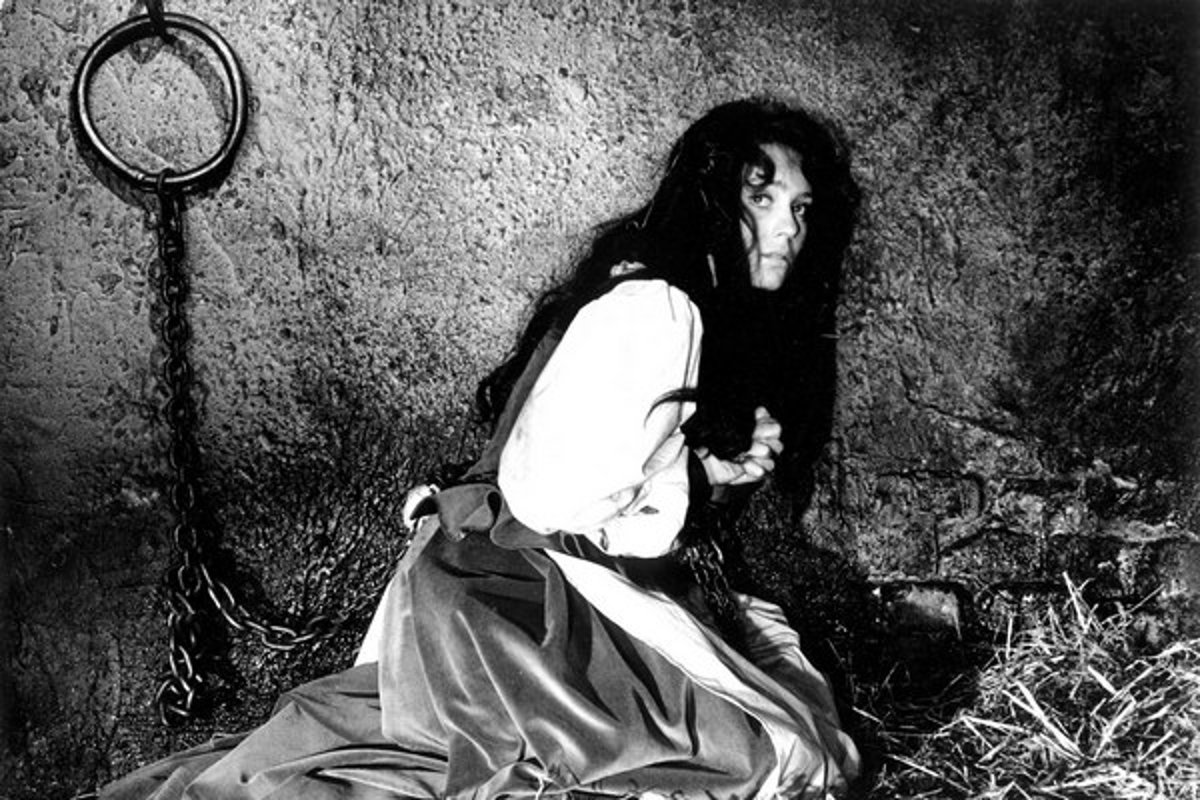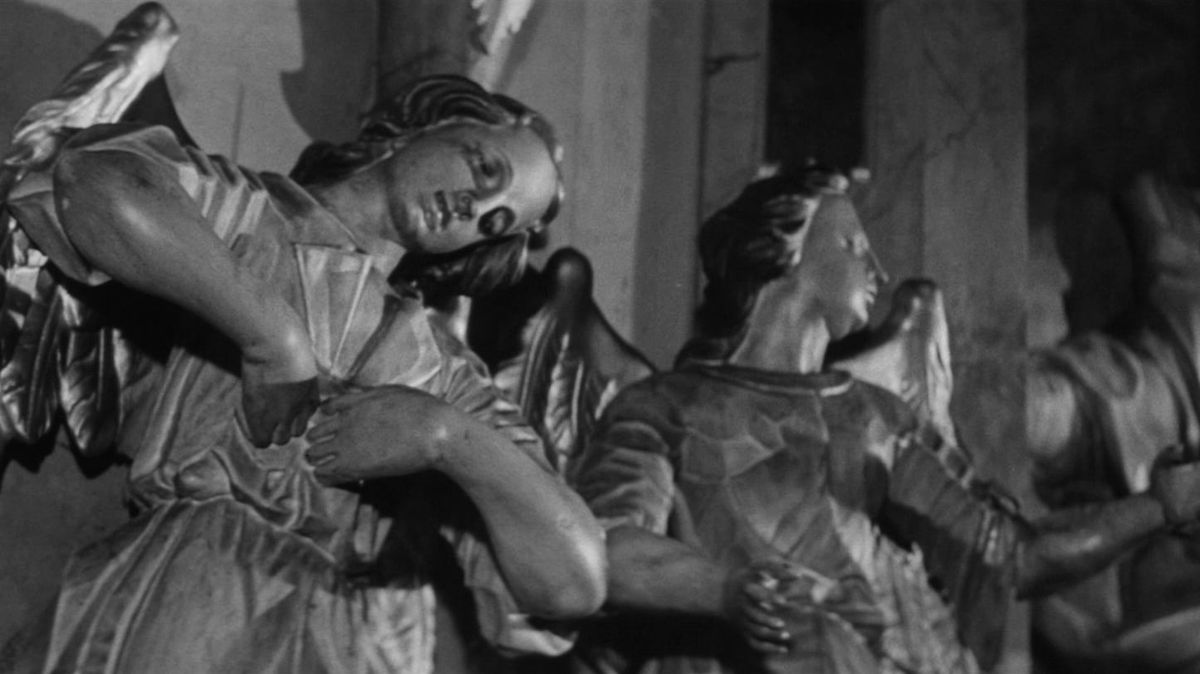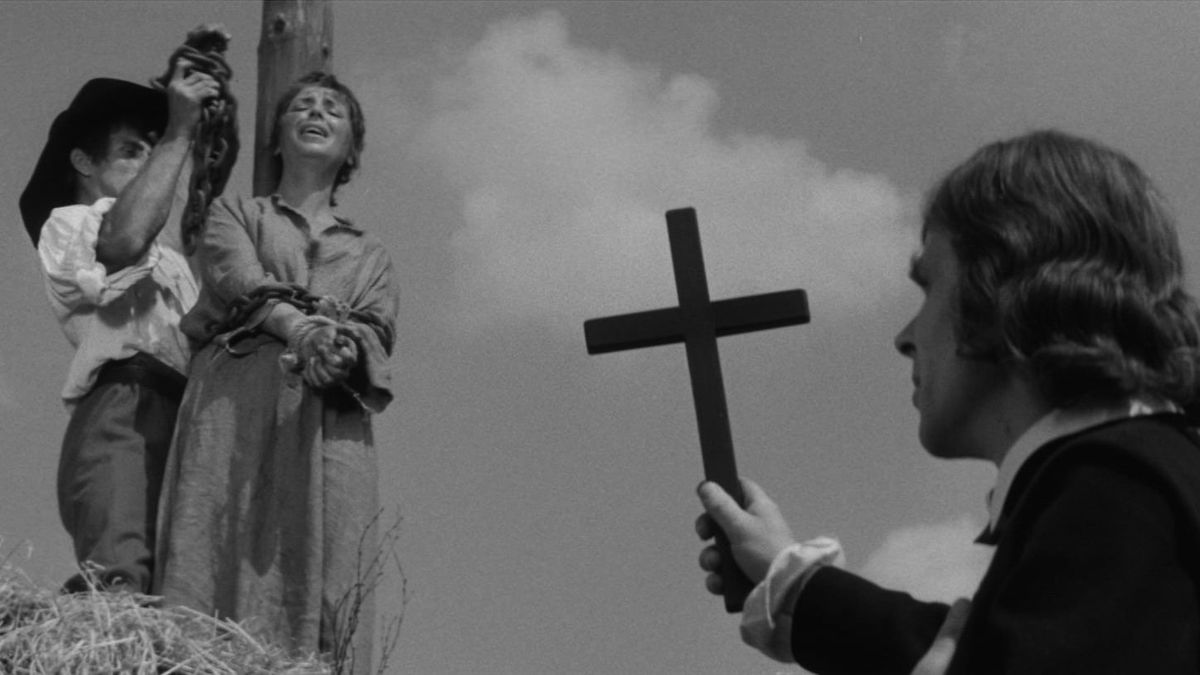The extremely rare A hammer for witches is inspired by a novel by Vaclav Kapliski coupled with the reports of trials with witches. A card indicates in the credits that
the procedural texts were taken from the authentic registers of the inquisition hearings during the trials of Losiny and Sumperk from 1678 – 1695
The film begins with a prologue which unambiguously displays the intentions of the film. A hooded monk with glassy eyes utters in a hallucinated way: “Through woman sin came into the world. woman is sin “. To support – ironically with the aim of deconstruction – this dominant position, the film does not bother with any taboos, frontally exposes, in a series of daring shots, the nudity of female bodies emerging most naturally from the world of the bath. Then again, the film returns in close-up to the preacher who continues to pour out his hatred towards the “so-called” weaker sex.
Copyright Artus films
Weak, to say the least, in the context in which the film is set. The action takes place in Moravia – former Czechia for part of the territory – in 1670. Superstitions fuel the irrational fear of an ignorant population under the influence of political and especially religious power. For having stolen a host, in order to treat her cow which no longer gives milk, a harmless old woman, in any case filmed as such, is accused of witchcraft. At the request of the village priest and the lord of the country, out of excess of zeal and/or obscurantism, summoned a judge, Bobling, who relied on the techniques of the inquisition to make the suspects confess who, under the torture, confess all the crimes that they obviously did not commit. Bobling is inspired by the famous manual Malleus Maleficarum, to conduct his interrogations. As a reminder, this tea towel, sorry, this treatise, written by the Dominicans Henri Institoris and Jacques Sprenger in the 15th century is a French invention. Yes, beautiful heresies have flourished in our dear country. The text was obviously used in the context of witch hunts through multiple editions and translations. If this bestseller was quickly condemned officially by the church Catholic, he continued to circulate secretly justifying the worst brutality and gratuitous murders. An ideal alibi for Bobling, presented from his first appearance, as the manager of an inn, like a pathetic impostor who never finished his studies but was able to practice his profession with impunity. He enjoyed an excellent reputation among the clergy before retiring. As soon as he puts on his judge’s outfit, confirming that if the habit does not make the monk, it gives him the power. And off we go for a long and relentless descent into hell with no possible way out. The judge, fully enjoying the situation, like a sadistic and hungry kid, multiplies arrests, tortures and death sentences at the stake. This staggering program never lets the spectator breathe, suffocated by a rectilinear narration, without embellishment, always at the service of a narration with the necessary austerity. Deviant bisserie lovers, be warned, The Witches’ Hammer follows paths closer to Dreyer than to Jess Franco, which in no way prevents it from being captivating from the first to the last image. Its director, Otakar Vavra, who was the mentor of Milos Forman and Jiri Menzel among others, seems to have been forgotten by dictionaries. Unknown in France, he has nevertheless produced around fifty feature films spread over more than sixty years. Died at the age of 100 exactly in 2011, he was the man of all regimes, going from Nazism to the most totalitarian communism, in which cinema allowed him, with all the compromises that one can imagine. This aside also allows us to better understand the ideological issues that infuse the film, disseminating a double discourse that is very obvious today but which deceived censorship at the time.

Copyright Artus films
A hammer for witches do not cheat. It is indeed a terrible indictment against the Church and, more broadly, the patriarchal society marked by its hatred and fear of women. And behind, the fear of seeing oneself dispossessed of power but also of accepting one’s weaknesses, one’s desires and one’s ability to question oneself. In this historical context, which, it seems, is not completely accurate but manages to generate a welcome universalism, it is finally more comfortable and reassuring to consider women as potential witches as soon as they deviate from the place that has been imposed on them. The second possible reading, obvious in the light of History, and taking into account the status of the filmmaker, takes on the appearance of allegories against totalitarian regimes, whatever they are since Otakar Vavra has known almost all of them. The charge is incredibly violent, revealing the madness of the men in power, sinking into abundance, excess. Bobling’s figure is deliberately enlarged, the better to make the viewer feel the feeling of injustice, the frustration of finding themselves at an impasse in the face of a desperately human monster in its worst baseness.

Copyright Artus films
Shot in cinemascope in a sumptuous black and white, whose images have a fairly realistic range, close to certain photographs of the war years, far from the aesthetic and baroque dimension of genre cinema, A hammer for witches shines with its concise and rigorous staging, of an absolute coherence even in the direction of actors, voluntarily stiff, who will not give you the pleasure of displaying a single smile. The sequences of torture, filmed off camera, nevertheless leave a strong impression by the choice of the director to show close-ups of the wounds on the feet and hands, also lingering on the terrified faces. Otakar Vavra’s position is clear. He describes a world in perdition, contaminated by evil, offering a vision marked by deep atheism coupled with absolute despair. No light sheds light on this painful journey to the end of Hell, lucid and uncompromising, far superior to The Mark of the Devil filmed the same year on a more than similar subject.
Released by Artus in a very nice copy, the DVD/Blu-Ray combo edition does not include any bonus except a slideshow.
© All rights reserved. Culturopoing.com is an entirely voluntary site (Association of law 1901) and respects the copyrights, in the respect of the work of the artists whom we seek to develop. The photos visible on the site are for illustrative purposes only, not for the purpose of commercial exploitation and are not the property of Culturopoing. However, if a photograph had nevertheless escaped our control, it will be removed immediately. We count on the kindness and vigilance of each reader – anonymous, distributor, press officer, artist, photographer.
Please contact Bruno Piszczorowicz (lebornu@hotmail.com) or Olivier Rossignot (culturopoingcinema@gmail.com).
We would love to thank the writer of this write-up for this incredible content
Otakar Vavra – “A Hammer for Witches”
Visit our social media profiles and also other pages related to themhttps://nimblespirit.com/related-pages/

